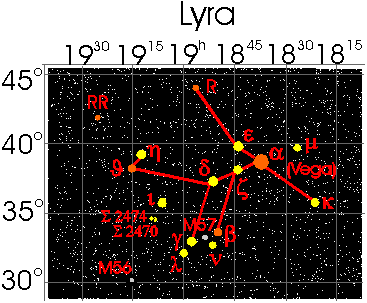
Lyra is extremely small but one of the most noticeable constellations, thanks to Vega, one of Summer's most prominent stars. For its size, Lyra is packed with interesting objects -- not only some very fine binocular binaries but also two significant variables as well as the best planetary nebula in the heavens.

Alpha Lyrae is Vega, the fifth-brightest star in the heavens at a visual magnitude of 0.03. Vega is very high in the skies around the first of July. It makes what is termed 'The Summer Triangle' with Deneb and Altair. Vega is found in an interesting region, with three nearby binary systems suitable for viewing. Delta1 and delta2 Lyrae is an optical binary only, but with a fine colour contrast, a blue-ish star (5.8) and a red variable (mag range from 4.2 to about 6.5). Epsilon1 and epsilon2 Lyrae is a splendid quadruple system, the famous ‘Double Double’. The two brightest members are easily split with binoculars or possibly even the naked eye; at 5, 5; position angle 173º and separation 208". Small telescopes bring out the other two members, making it one of the finest binary sights. Zeta1 and zeta2Lyrae also form a binocular binary, with magnitudes of 4.3 and 5.7, position angle 150º and separation 43.7". Finally, you might try to find the bright red star known as T Lyrae, just to the southwest of alpha in the same FOV.
T Lyrae is an irregular variable, with a range from about 7.5 to 9.4. You'll know if you spot it by its brilliant shade of red.
Beta Lyrae is Sheliak (The Tortoise, which was what the Arabs called the entire constellation). This is a very fine binary for small telescopes (creamy-white and blue)as well as an irregular variable: every thirteen days it drops from 3.2 to 4.4 magnitude. Compare with nearby gamma Lyrae (3.3), to the southeast. Beta Lyrae is just south of delta Lyrae. In the same FOV is the remarkable planetary nebula known as The Ring Nebula (M57). While large binoculars might pick out the object, it's best seen in medium to large telescopes.
Delta1 and delta2 Lyrae is an optical binary only, but with a fine colour contrast, a blue-ish star (5.8) and a red variable (mag range from 4.2 to about 6.5).
Epsilon1 and epsilon2 Lyrae is a splendid quadruple system, the famous ‘Double Double’. The two brightest members are easily split with binoculars or possibly even the naked eye; at 5, 5; position angle 173º and separation 208". Small telescopes bring out the other two members, making it one of the finest binary sights.
Zeta1 and zeta2Lyrae also form a binocular binary, with magnitudes of 4.3 and 5.7, position angle 150º and separation 43.7". Finally, you might try to find the bright red star known as T Lyrae, just to the southwest of alpha in the same FOV. T Lyrae is an irregular variable, with a range from about 7.5 to 9.4. You'll know if you spot it by its brilliant shade of red.
R Lyrae is a semi long-period variable with a range of one magnitude, 4 to 5 and a period of about 46 days. R Lyrae is (barely) in the same FOV as Vega, to the northeast. If you now place R Lyrae at the bottom of your glasses, 16 Lyrae is nearly centred. This is a 5.0 mag star, and is a convenient star by which to judge the magnitude of R Lyrae.
RR Lyrae is the prototype of a class of variables (that is, the ‘main’ star in that category, usually the first star discovered with its particular characteristics). RR Lyrae variables are very old giants which pulsate. Their period is quite short, less than one day. They usually inhabit globular clusters. RR Lyrae has a period of 13h 36m and a range of one full magnitude, 7.1 to 8.1. The star is in the same FOV as theta Lyrae.
Theta Lyrae is in the same field as delta. It's a convenient star for locating the intriguing variable RR Lyrae.
